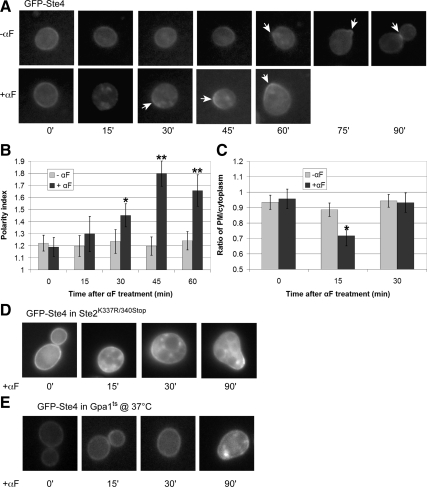Figure 10.
Pheromone-induced internalization and polarization of Gβ (Ste4). (A) Representative fluorescent images of GFP-Ste4 localization in the wild type strain DSY257. G1-synchronized cells were treated with 30 nM pheromone (0 time) or cultured without pheromone and images were acquired every 15 min. Arrows indicate GFP-Ste4 crescents. (B) Quantification of GFP-Ste4 polarization. The bar graphs represent the mean polarity index ± SD at each time point (n = 15). The GFP-Ste4 reporter displayed significant cell cycle dependent localization in untreated cells, concentrating at the incipient bud site and at the mother-daughter neck, and polarized dramatically in response to the pheromone (*p < 0.0001 compared with 0 min and p < 0.001 compared with the same time point in untreated cells; **p < 0.0001 compared with the same time point in untreated cells). (C) Ratio of GFP-Ste4 plasma membrane to intracellular signals. The bar graphs represent the mean ratio ± SD of the plasma membrane to cytoplasmic signals at each time point (n = 15). (*p < 0.001 compared with the same time point in untreated cells). (D) Pheromone-induced Gβ internalization and early polarization depends on receptor internalization. A mid-log phase culture of Ste2K337R/340Stop cells expressing GFP-Ste4 from a centromeric plasmid were treated with 30 nM pheromone (0 time) and imaged at the indicated time points. Representative fluorescent images are shown. None of the cells examined showed clear evidence of GFP-Ste4 internalization (n ≥ 50). (E) Pheromone-induced Gβ internalization and polarization depends on Gpa1. A mid-log phase culture of gpa1ts cells expressing GFP-Ste4 from a centromeric plasmid were treated with 30 nM pheromone at the permissive temperature (0 time for the 23°C cultures) or 5 min after the shift to restrictive temperature (0 time for the 37°C cultures) and imaged at the indicated time points. Representative fluorescent images are shown. None of the cells examined showed evidence of GFP-Ste4 internalization (n ≥ 50).

